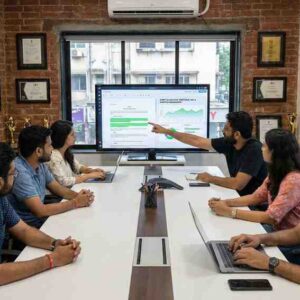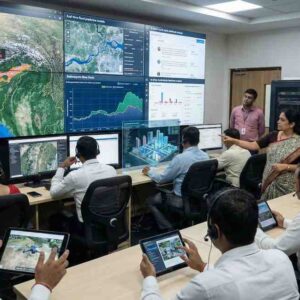An in-depth look at how artificial intelligence is reshaping urban planning and development across India, enabling smarter, more sustainable, and livable cities.
Key Highlights
- Smart City Mission Integration: Leveraging AI to manage resources and improve urban infrastructure.
- Traffic and Transportation Optimization: AI-driven solutions to reduce congestion and improve public transportation.
- AI for Sustainable Development: Tools to monitor environmental impact and promote green initiatives in urban areas.
- Data-Driven Policy Making: AI analytics to guide urban planning decisions and resource allocation.
1. Smart City Mission Integration
The Indian government’sSmart Cities Missionincorporates AI technologies to enhance urban infrastructure and management. AI tools are used to monitor water and power consumption, manage waste, and optimize the use of city resources, ensuring efficient and sustainable urban growth.
Applications Under Smart Cities Mission:
- AI-powered smart grids for energy distribution, reducing power outages and enhancing energy efficiency.
- Waste management systems that use AI to monitor collection schedules, sort waste, and track landfill capacities.
2. Traffic and Transportation Optimization
AI is instrumental in addressing one of urban India’s most pressing challenges: traffic congestion. By analyzing real-time data from sensors, cameras, and GPS systems, AI provides insights to optimize traffic flow and improve public transportation systems.
Technological Impact:
- AI-powered traffic signal systems like those implemented in cities such as Bengaluru and Pune dynamically adjust signal timings based on real-time traffic conditions, reducing wait times and fuel consumption.
- Predictive analytics used by transportation departments to design smarter routes and schedules for buses and metro systems.
3. AI for Sustainable Development
Urban areas in India face significant environmental challenges, including air pollution and waste management. AI technologies are helping cities adopt sustainable development practices by monitoring environmental data and implementing green initiatives.
Sustainability Enhancements:
- AI systems that monitor air quality and identify pollution sources, allowing authorities to take targeted action.
- AI-driven tools for urban forestry planning, ensuring optimal placement of green spaces to combat urban heat islands and improve air quality.
4. Data-Driven Policy Making
AI enables urban planners to make informed decisions by analyzing vast datasets related to population growth, infrastructure demands, and socioeconomic trends. These insights help in designing cities that are resilient, inclusive, and future-ready.
Policy Applications:
- AI analytics used in housing development to predict future demand and ensure affordable housing availability.
- Integration of AI in urban disaster management plans, using predictive models to identify vulnerable areas and prepare for potential risks.
Challenges and Opportunities
While AI holds immense potential for urban planning, challenges such as data privacy, high implementation costs, and the need for skilled professionals remain. To fully realize AI’s benefits, the government must prioritize investment in digital infrastructure, training programs, and the development of ethical AI frameworks.
Conclusion
AI is proving to be a game-changer in urban planning and development in India. By integrating advanced technologies into the Smart Cities Mission and beyond, the government is transforming urban areas into smarter, more efficient, and sustainable environments. As these efforts scale up, India’s cities are poised to become global benchmarks for leveraging AI in urban development.













